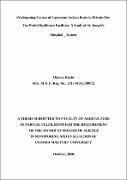| dc.description.abstract | Introduction: Caesarean delivery, often called a C-section, is the delivery of the baby through incisions in the mother’s abdomen and uterus. Caesarean deliveries, whether elective or medically necessary, have risen dramatically in recent decades across the globe. This made evidence-based research on methods, post-operative care and how to safely reduce their incidence became more imperative. According to World Health Organization, the ideal Caesarean Sections Rate (CSR) is between 10-15%. Over the years, however, caesarean sections have become increasingly common in both developed and developing countries. When medically necessary, a caesarean section can effectively prevent maternal and newborn mortality. When CSR rise towards 10% across a population, the number of maternal and newborn deaths decreases but when the rate goes above 10%, there is no
evidence that mortality rates improve. The lack of a standardized internationally-accepted classification system to monitor and compare CSR in a consistent and action-oriented manner is one of the factors that have hindered a better understanding of the trend of CSR.
Objectives: The main objectives of the study were to; determine the mean CSR in St. Josephs’ Hospital _ Kitovu and ascertain the determinants of Caesarean Section. The study also established the attitude of health managers towards monitoring and evaluating Caesarean Section
Methodology: The design was both descriptive and analytical cross-sectional study. It was both qualitative and quantitative in dimension. 318 respondent mothers who were admitted to Maternity ward or delivered from the said ward and health manager were interviewed. Document review guide, interview guides and semi-structured questionnaires were the research tools used to extract data. Ethical considerations and quality controls were taken care of
Results: The study found the Average CSR for St. Joseph’s Hospital _ Kitovu was 47.6%.53.3% of the respondents mothers who had Caesarean delivery were 20-40years of age and that being in this age category was 0.4times less likely to predispose one to
Caesarean delivery (COR =0.378, CI(0.114-1.256)). Conversely, being more than 40years of age is 1.3times more likely to make the respondent deliver by Caesarean section (COR=1.286, CI(0.471 - 3.514)). It also found a number of predisposing factors were associated or influenced Caesarean delivery in St. Joseph’s Hospital Kitovu. These were; Age of respondent less than 20years (p=.041), not being married (p=.015), educational level of respondents (p=.000), living in urban setting (p=.001), among others. All the socio-economic determinants (regular household income, p=.000, and occupation, p=.000) highly influenced caesarean delivery in the health facility. Mothers who lived in urban setting were 2.8times more likely to deliver by Caesarean section as opposed to their rural counterparts (p=.001, COR= 2.764, CI(1.542 – 4.953). Respondents who earned UGX100.000/= to UGX300.00/= and those who earned more than UGX300.000/= were 11times and 2times more likely to deliver by Caesarean section (COR= 11.106, 2.238 respectively) than those mothers who earned less than UGX100.000/=.
Lastly, mothers whose reason for preferred choice of mode of delivery was based on doctor’s suggestion were 2.4times more likely to deliver by Caesarean section. Likewise, mothers whose choice of mode of delivery was based on husband’s preference were less likely to deliver by Caesarean section (COR=0. 135, CI(0.021 – 0.855)).The views of the health manager were in support of regularizing monitoring and evaluation of Caesarean Section Rates (CSR).
Conclusion & Recommendation: The Caesarean Section Rate (47.6%) in Private Not-For Profit Healthcare organization is still unacceptably higher than WHO recommendation of 10-15%. Therefore, there is stronger need to regularize monitoring and evaluation of CSR. | en_US |


